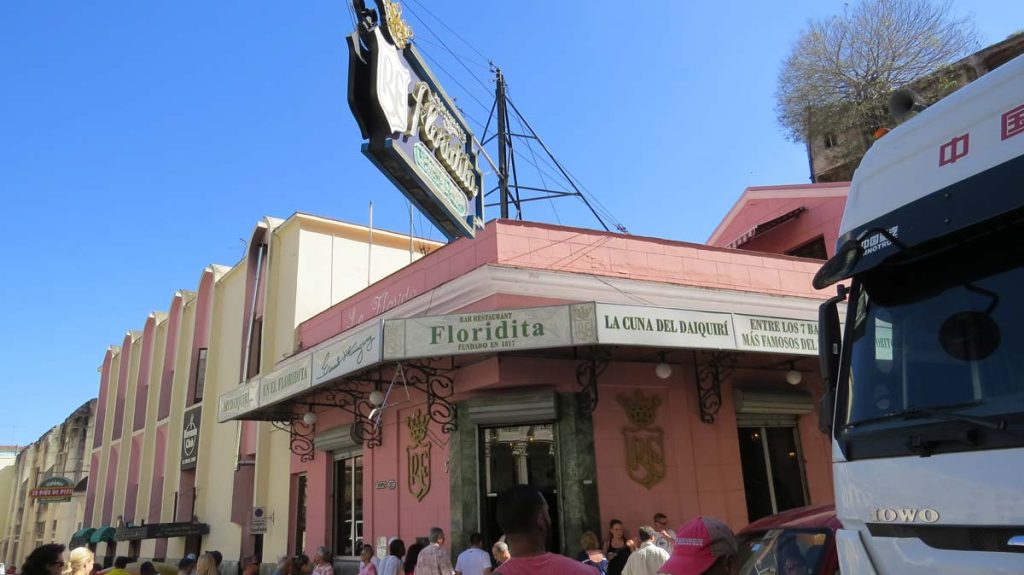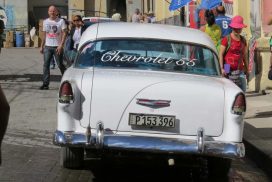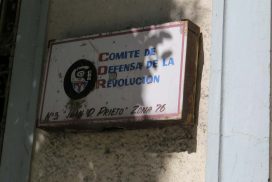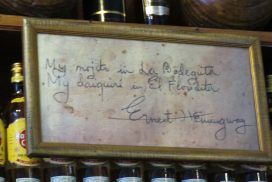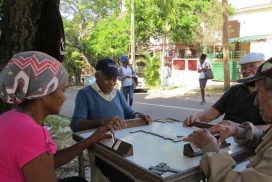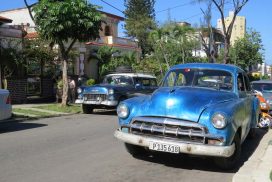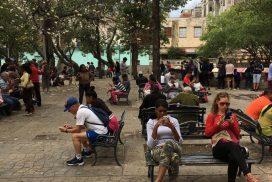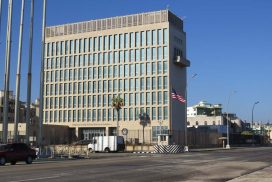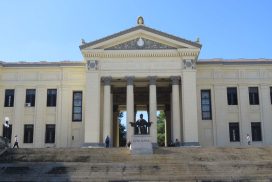

Doctors at UM’s Miller School of Medicine partner with a Havana hospital to share information around trauma care.
It’s Sunday afternoon and American Airlines Flight 2699 from Miami touches down on the runway at Jose Marti International Airport on the outskirts of downtown Havana.
Outside the terminal, Dr. Tanya L. Zakrison, a surgeon at Jackson Memorial Hospital’s Ryder Trauma Center in Miami, changes dollars into the Cuban Convertible Peso, or CUC. She hops into the yellow taxi for the journey towards town along Avenida de la Independencia.
Cars both old and older jostle through the bends and turns—plenty of American classics mixed with Russian Ladas and a Moskvich, along with Peugeots and Kias.
Dotting the landscape and street corners are billboards and posters with familiar revolutionary faces—Argentinian Marxist Che Guevara, with his trademark beret and its single star; the bearded dictator Fidel Castro, who died November 25, 2016; and his brother Raul Castro, the aging and diminutive leader who has been in power since 2008 and brokered the controversial softening of relations with the United States and former President Barack Obama known as “the rapprochement.”
About the Photo
Medical students at the University of Havana take a break between classes in an open-air courtyard on campus. Photo credit: Peter E. Howard
Join the Conversation:
Follow on
Twitter:
UM Miller School of Medicine, @umiamimedicine
University
of Miami, @univmiami
UM News, @univmiaminews

Zakrison points to other banners on the stonewalls and hillsides delivering social messages on safe sex and combating domestic abuse.
“You see these signs everywhere,” she says. “They are pretty much propaganda, but they talk about the benefits of the revolution, or have quotes from independence fighters like Jose Martí, or have lots of slogans about the genocidal nature of the U.S embargo.”
Zakrison, an assistant professor of surgery at the University of Miami’s Miller School of Medicine, is in Havana to attend an international conference at the University of Havana’s General Calixto Garcia Hospital. She will be presenting on aspects of trauma care, and renewing friendships with Cuban peers that date back more than two decades.
A Canadian by birth, Zakrison has been visiting Cuba on family vacations off and on since she was 7 years old. She studied human biology as an undergrad at the University of Toronto, and during those formative years spent time abroad in Finland in the Arctic Circle at the University of Lapland. In her junior year she traded snow boots for sandals and headed back to the tropics, spending the full year at the University of Havana.
“It was total immersion in the language and the culture,” she says. “But it was a very international experience. There were people there from Africa, from Latin America, from countries like North Korea, Laos and Western Sahara. I learned a lot about the world, not only about Cuba.”
The taxi pulls in to Abby’s Place in Havana, a bed and breakfast just a stone’s throw from the Malecón, the famous esplanade and seawall that stretches eight kilometers along Havana’s coastline. Zakrison gives a warm hug to its owner, Anna.
This will be home during the next three days as she attends the conference at Calixto Garcia.
“El Himno de Bayamo”
It’s Monday morning at the January conference and Cuban colleagues greet Zakrison with warm hugs, kisses on the cheek and smiles as she walks on the speckled terrazzo floors into the aging auditorium at Calixto Garcia. She’s met by Dr. Martha Larrea Fabra, professor of general surgery at the hospital, and Dr. Yamilét Valdéz González, chief of the Department of Education and Research, and assistant professor of internal medicine.
The seats, arranged in a horseshoe shape with a steep slope, are Fenway Park-tight—rib cages nestle next to armrests. On the walls are posters of Raul Castro and one of Fidel Castro, arm extended holding the popular Kalashnikov assault rifle developed in the former Soviet Union.
“Revolution is unity, it is independence, it is to fight for our dreams and justice for Cuba and the rest of the world,” the quote on Fidel Castro’s poster says. “It is the basis of our patriotism, our socialism and our internationalism.”
Everyone stands as they sing the national anthem, El Himno de Bayamo, which traces its roots back to the Battle of Bayamo in 1868 that was waged in Cuba’s fight for freedom against Spanish rule.
…You do not fear a glorious death
Because to die for the country is to live…”
 Several doctors receive awards and
recognitions. National athletes and the country’s top
dominos players are introduced to applause. After a
presentation on cranio-facial tumors by a visiting Mexican
maxillofacial surgeon, the auditorium empties as conference
participants file out to attend various sessions being held
throughout the sprawling complex of classrooms and hospital
buildings—several under repair and framed by wooden
scaffolding—that dot the campus of Calixto Garcia.
Several doctors receive awards and
recognitions. National athletes and the country’s top
dominos players are introduced to applause. After a
presentation on cranio-facial tumors by a visiting Mexican
maxillofacial surgeon, the auditorium empties as conference
participants file out to attend various sessions being held
throughout the sprawling complex of classrooms and hospital
buildings—several under repair and framed by wooden
scaffolding—that dot the campus of Calixto Garcia.
Zakrison stands at the head of one of the classrooms. In the audience are students, administrators and a former professor she knows from her days as a student at the University of Havana. They are dressed in suits and medical scrubs, with one man wearing jeans and a white guayabera. Her two presentations involve case studies on trauma patients from Miami—one with a gunshot wound and a 22-year-old suffering from multiple stab wounds who shot his assailants following his recovery. The young man claims he suffered post-traumatic stress disorder and doesn’t remember his assault.
“What is the role of the clinician in recognizing structural violence?” Zakrison, who speaks fluent Spanish, asks the audience.
Later on, before nibbling on a box lunch of chicken and black beans and rice, Zakrison is interviewed by a Havana radio station about the conference. Students dressed in white and blue uniforms, and conference attendees mingle nearby.
Finding Value in Partnerships
For the past five years Zakrison and other doctors from the Miller School of Medicine have been visiting Calixto Garcia to study and share techniques in trauma care.
Zakrison kick-started the partnership with Dr. Marc A. de Moya, a former fellow in the trauma surgery program at UM/Jackson Memorial Hospital who is now an associate professor of surgery at Harvard Medical School.
Before this January visit, Zakrison was at Calixto Garcia in November 2016 with several UM surgeons, including Dr. Enrique Ginzburg, professor and vice chair of the Department of Surgery and trauma medical director at Jackson South Community Hospital.
Born in Cuba and raised in the Cuban culture, Ginzburg was overwhelmed by his return to Cuba and visit to the house he remembered from childhood. He’s embraced the partnership with Calixto Garcia—which he describes as the “Jackson Memorial Hospital of Havana”—and is hopeful the Miller School can begin an exchange program for medical students.
“I think it’s something we can expand,” says Ginzburg, who helped develop trauma systems in Argentina and Israel, and helped start UM’s trauma hospital in Haiti with Barth Green, professor and chair of neurological surgery at the Miller School and co-founder of Project Medishare in Haiti. (See Haiti Special Report.)
“We’ve been opened up,” he says of the new relationship between Cuba and the U.S. “Cruise lines are going down there. American businesses are expanding down there. One way to make these U.S. industries more comfortable is to make sure there is excellent medical care available.”
Cuba’s national health care system has a strong reputation. But technology and materials are limited and some medicines are scarce for the everyday Cuban. Doctors are not paid well, and many opt to travel to other countries on health missions from Cuba that pay more.
Despite the differences, says Ginzburg, the exchange of ideas about trauma care is valuable to everyone. Due to the strict gun laws in Cuba, he says, doctors rarely see patients with gunshot wounds. Most patients are treated for blunt trauma caused by car and scooter accidents, and falls.
Complications and Contradictions
Zakrison experiences a bubbling caldron of emotions during her visits to Cuba. She remembers playing in the ocean waves as a child on family vacations. She recalls the homesickness she felt during her year of study at the University of Havana. She sees a people who endure hardship after hardship—physical, economic and otherwise—living in the shadow of a country viewed as repressive by some, and seen by others as humane and just, despite the persistent hardships.
She also remembers friends from her study abroad experience, including some from the poorest corners of the world, being given the opportunity to develop their human potential through universal and free access to health care, university-level education and through exposure to a rich and deep culture. And she knows others who left the country in order to earn by the hour what would take them a month to earn in Cuba.
She knows Cuba is complicated.
(Story continues after photo gallery)
Not just due to what has transpired since the 1959 revolution that put Fidel Castro in power. Or the Committees for the Defense of the Revolution—the groups that dot every neighborhood and are used to act as local spies for the government. Or that more than a million Cubans have fled to the U.S. and other countries over the years. Or due to the tenuous relationship with the U.S. resulting in economic embargoes and sanctions, boat lifts and the white-knuckle affair known as the Cuban Missile Crisis.
But just in simple observations:
• A two-currency system: tourists enjoy the Cuban Convertible Peso, or CUC, economy, while most locals barter with the Cuban Peso, or CUP - with only half of the population able to access CUCs on a regular basis.
• A visible caste system between the have and have-nots, despite the overarching principle of an egalitarian society.
• A society dipping its toe into technology advancements.
On one busy street corner four elderly men and women—smiles engaged and skin weathered by age and climate—slap dominos onto a simple card table. Opposite sit hordes of younger Cubans hungry for information on the World Wide Web.
Cuba now sells Wi-Fi cards that allow access to the internet. But only in designated hot spots usually found on street corners and parks. With phones in hand, they toggle through their searches. They sit quietly, ignoring all around as they focus on the tiny illuminated screens on their phones.
Down the street, Cubans laugh and talk. Some sit in doorways, watching people walk by on rugged sidewalks filled with potholes and cracked cement. Some stop at small eateries of inferior quality that only take the Cuban peso, while talking loudly and animatedly among themselves.
It’s a clash of a changing culture.

At the Hotel Nacional de Cuba tourists gather for dinner, a chilled Cristal beer or a stemless goblet of the famous Cuban Mojito, made with yerba buena, a mint herb. Built in 1930, the eight-story hotel stands proudly on a bluff high above the Malecón and the Gulf of Mexico. In the distance is Castillo de los Tres Reyes Magos del Morro, a stone fortress built in 1589 to protect the city’s harbor. Now its fiercest adversary are the constant rolling waves that assault its foundation.
The tourists—paying anywhere from $300 to $1,100 a night—share a space once visited by Winston Churchill and Frank Sinatra. It’s said the hotel hosted the 1946 Havana Conference, a meeting of mobsters that was dramatized in the second part of The Godfather trilogy. Fidel Castro and Che Guevara hunkered down at the hotel during the 1962 Cuban Missile Crisis.
Parked outside the entrance are dozens of American classic cars. Cadillacs with fins. Lots of Chevys from the 1950s. Convertibles. Hard tops. All available for hire for touring and fun. Down the street a restaurant caters to the Habaneros, who can only pay with the lowly Cuban peso.
Contradictions and complexity abound, but Zakrison says, “there has always been a rhythm to life here.”
Salsa and Smiles
As night descends on Havana, attendees to the Calixto Garcia conference weave their way through neighborhoods to an open air bar and restaurant. A string of colorful lanterns provides soft light.
The conference coincided with the 121st anniversary of Calixto Garcia Hospital, named after the famed Cuban general, Calixto Garcia Iñiguez, who fought in three wars, including the Spanish-American War. When he died in 1898, he was initially buried in Arlington National Cemetery before being returned to Cuba.
The night’s party is festive, bordering on talent show. Hospital staff sing songs while the crowd dances, drinks, and dines on chicken. Conga lines snake through the tables and chairs, and a medical student visiting from the Czech Republic happens upon the restaurant and joins in.
“Shake it, move it,” a man sings in Spanish, his Salsa moves in step to the music, “until the Malecón dries up!”
- PETER E. HOWARD / UM News
